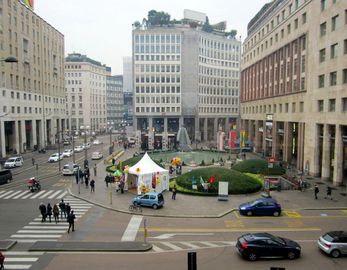

No other square in Milan has undergone so much urban change in the last one hundred years than Piazza San Babila. In fact, it appears to be the most modern square in the city, always covered with neon light and advertisements, aspiring to the look and character of Times Square in New York, as much as that is possible.
Ever since the Middle Ages the area around the present square had always been home to merchants and their businesses. In the 18th century there was already a concrete open space connecting various streets around it. Talk of enlarging the square began at the end of the 19th century but it was only after World War I, in the 1920s, that the municipal government embarked on a sophisticated restructure project that would connect Corso del Littorio, the present Corso Matteoti, which leads to La Scala, with the important Corso Venezia artery.
The project was approved in 1931 and work began immediately to expand and modernize the square. Old buildings and structures had to be torn down to make room for the new ones. One of the new edifices was the Snia Viscosa Tower at the northwestern corner of the square, at the beginning of Montenapoleone, built in 1937 by architect Alessandro Rimini. Sixty meters high and boasting 15 floors, it was the first skyscraper in the city, holding that title for 14 years. Another important structure that had to be sacrificed was the Galleria de Cristoforis, connecting Corso Vittorio Emanuele with Via Montenapoleone. It had been the first commercial galleria in Italy, and one of the first in the country to use iron and glass. In its place architect Emilio Lancia built the enormous Palazzo del Toro in 1939, named after the Toro Insurance Company, which still has an office in the building. The building dominates the western side of the square. In it, on the underground floor, theater lovers can find the famous Teatro Nuovo, where Anna Magnani used to perform before becoming an international film star.
In 1938, to the regret of the local residents and shop owners, a symbolic element in the square had to be demolished: the Venetian houses. These houses had been built in 1859, immediately after Lombardy defeated the Austrians and joined the Kingdom of Savoy. Standing on the eastern side of the square, they were exact replicas of the palaces found in Venice. The meaning behind their construction was rather simple: in 1859 Venice was still Austrian territory and by erecting these Byzantine-styled edifices Milan was expressing its solidarity with Venice, encouraging it to continue fighting the Austrians and unite with the rest of Italy, which it ultimately did in 1866. Instead of the Venetian houses after World War II architect Gio Ponti built the complex of buildings that today contains the Galleria San Babila and opens to the Piazza Umberto Giordano behind it. Finally, in 1957 architect Luigi Mattioni constructed the office building at the angle of Corso Vittorio Emanuele and Corso Europa, which today includes the winding Galleria Passarella.
Starting in the late 50s to the beginning of the 60s Piazza San Babila was excavated to make room for the Red Line metro stop (the construction of the Milanese metropolitan had begun in 1957). In the 60s and 70s the square was a gathering point for youths with political views that inclined towards the far right. In fact, Milanese newspapers began calling these youths sanbabilini, a euphemism for young Fascists. The far-right sentiment grew so intensely that militant, para-political parties began springing up all over Milan and Piazza San Babila was always the meeting place. One day in 1973 a far-right demonstration was organized in the bars around the square. Later in the day the protesters were responsible for the death of a policeman in what became known as Black Thursday. Three years later two sanbabilini murdered a sixteen-year-old female student in a clash of political sympathies.
In the 80s and 90s, after the ideological confrontations among the population had subsided and capitalism remained the only political-economic course for the West, Piazza San Babila gradually became the commercial and financial heart of Milan. Today, besides the cafes and the middle-range shops and boutiques, the buildings around the square house offices of the most prestigious Italian banks, insurance companies, consulting societies and investment firms. Due to its central and easily accessed location, San Babila is also the favorite meeting place among the Milanese - for lunch, dinner or just an afternoon of shopping.